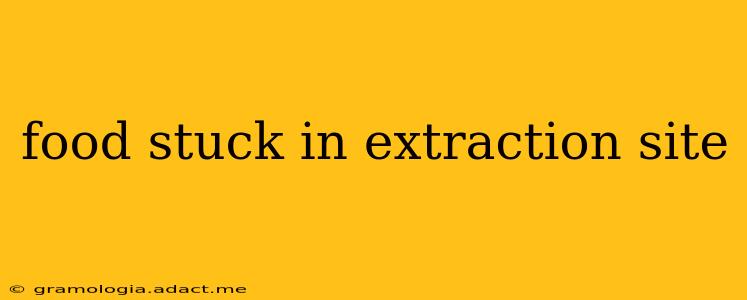Losing a tooth is never fun, but the healing process after an extraction can be surprisingly tricky. One common concern is food getting stuck in the extraction site. This can be uncomfortable, even painful, and raise concerns about infection. This comprehensive guide will address your worries and provide clear steps on how to handle this situation.
What Happens After a Tooth Extraction?
Following a tooth extraction, a blood clot forms in the socket. This clot is crucial for healing; it protects the bone and nerves underneath, preventing infection and promoting healthy tissue growth. If food particles become lodged in this delicate area, it can dislodge the clot, leading to a painful condition known as a "dry socket."
Why Does Food Get Stuck in My Extraction Site?
Food particles can easily become trapped in the extraction site because the area is raw and sensitive. The socket is often uneven, creating crevices where food can hide. The type of food consumed also plays a role; hard or sticky foods are more likely to become lodged.
How Do I Remove Food from My Extraction Site?
Gentle is Key: Avoid poking or using sharp objects to dislodge the food. This can damage the healing tissues and dislodge the crucial blood clot.
Instead, try these gentle methods:
- Saltwater Rinse: Mix a half-teaspoon of salt into eight ounces of warm water. Gently swish this solution around your mouth, avoiding the extraction site directly. This helps cleanse the area and loosen any particles. Do this several times a day.
- Soft-Bristled Toothbrush: Very gently brush around the extraction site with a soft-bristled toothbrush, ensuring you're not disturbing the healing area.
- Oral Syringe: Your dentist might recommend using a syringe to gently irrigate the area with saltwater. Follow their instructions carefully.
What if I Can't Remove the Food?
If you've tried these methods and food remains lodged, contact your dentist or oral surgeon immediately. They have the tools and expertise to remove the food safely and assess the healing process. Delaying treatment can increase the risk of complications.
What are the Signs of a Dry Socket?
A dry socket occurs when the blood clot dislodges from the extraction site, exposing the bone and nerves. Symptoms include:
- Severe pain: This pain typically starts 2-3 days after the extraction and is often more intense than the initial post-extraction discomfort.
- Bad odor or taste: The exposed bone can lead to a foul smell or taste in the mouth.
- Visible empty socket: You may be able to see the empty socket without a blood clot.
How Can I Prevent Food from Getting Stuck in My Extraction Site?
Prevention is always better than cure. Here are some tips to minimize the risk of food getting trapped:
- Follow your dentist's post-operative instructions carefully.
- Eat soft foods for the first few days after the extraction. Think soups, mashed potatoes, yogurt, smoothies – nothing that requires excessive chewing.
- Avoid using straws: Sucking can dislodge the blood clot.
- Avoid smoking and alcohol: These can interfere with the healing process and increase the risk of infection.
- Avoid rinsing vigorously: Gentle rinsing is crucial; vigorous rinsing can dislodge the clot.
What if I Experience Swelling or Bleeding?
While some minor swelling and bleeding are normal after an extraction, excessive bleeding or significant swelling should be addressed promptly. Contact your dentist or oral surgeon for guidance.
Is it Normal to Feel Some Discomfort?
Yes, some degree of discomfort is expected after a tooth extraction. However, severe or persistent pain, or any concerning symptoms, warrants immediate professional attention.
When Should I Call My Dentist?
Contact your dentist immediately if you experience:
- Severe pain
- Excessive bleeding
- Significant swelling
- Signs of a dry socket
- Food that you cannot remove gently
Remember, proper post-extraction care is vital for a smooth recovery. By following these guidelines and promptly addressing any concerns, you can significantly reduce the risk of complications and ensure a healthy healing process. Always consult your dentist or oral surgeon if you have any questions or concerns.
